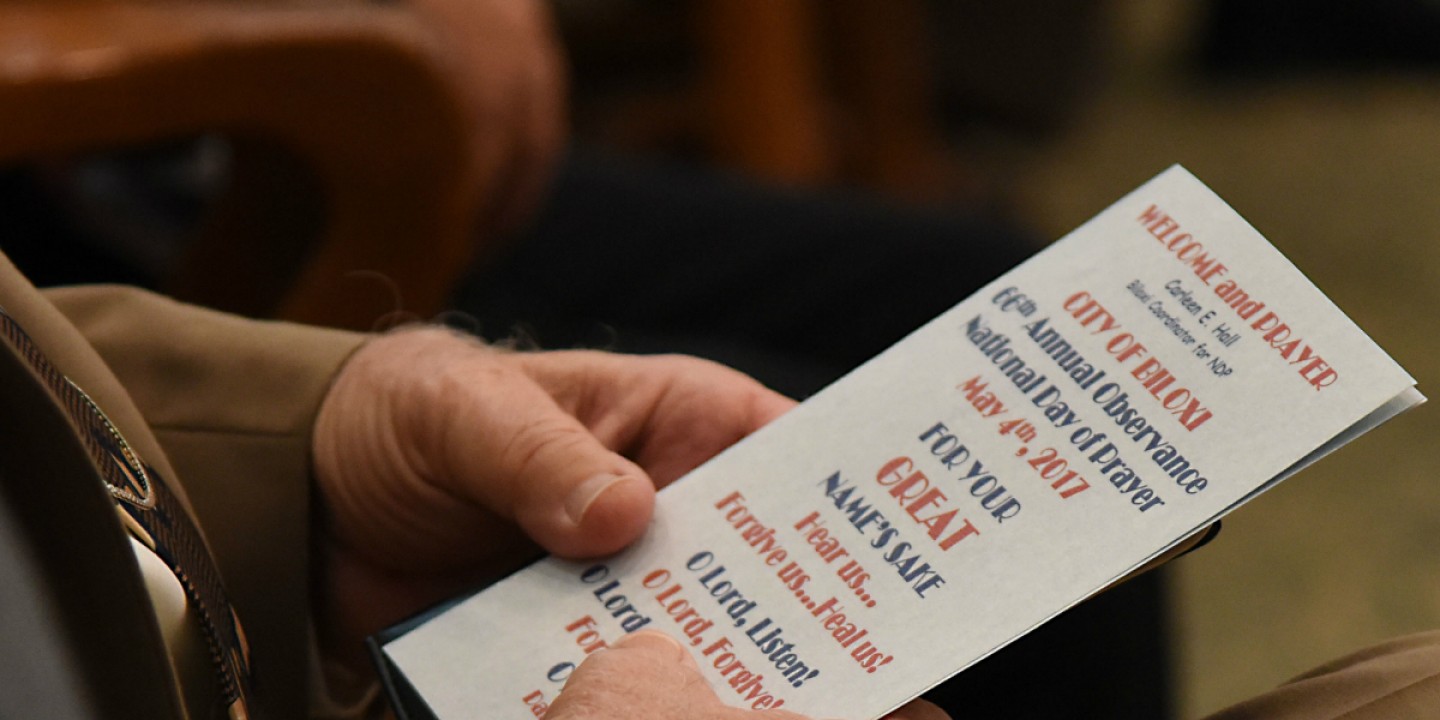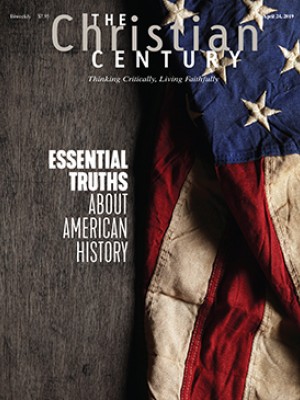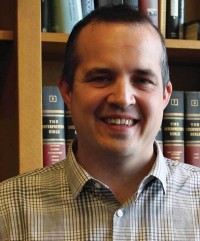The National Day of Prayer and the sectarian group that uses its name
People often perceive the National Day of Prayer Task Force’s events as official. They aren’t.

In January, the National Day of Prayer Task Force changed the logo on its website. The old logo relegated the words “Task Force” to small type at the bottom. The new one omits them altogether—it’s just “National Day of Prayer” and a stylized American flag.
The new logo joins the group’s web domain (nationaldayofprayer.org) and social media identity (@NatlPrayer on Facebook and Twitter) in perpetuating a confusion of terms. National Day of Prayer is in fact simply the name of a federal law, a nonsectarian annual observance enacted by Congress that falls on the first Thursday in May. The National Day of Prayer Task Force, on the other hand, is a conservative evangelical organization that’s behind the most prominent National Day of Prayer events. For years, these two very different things have frequently been conflated by casual observers, who often perceive the task force’s work as representing the law in some official way. It doesn’t. (The National Prayer Breakfast in February is yet another entity, hosted by an unrelated group.)
Read our latest issue or browse back issues.
The logo change came as part of a broader website redesign alongside the release of Pray, a new magazine published by NDPTF. (That’s an acronym the organization generally avoids in favor of NDP, though an unused @NDPTF Twitter account does exist.) It’s not clear, however, what prompted the specific decision to drop “Task Force” from the logo, and NDPTF didn’t respond to requests to comment for this article. In any case, the more the group calls itself simply National Day of Prayer, the fuzzier the distinction becomes in the public eye—with consequences for the politics of the NDP law and of public prayer generally.
While the practice of setting aside a day in the spring for national prayer goes back to 1775, the modern observance began in 1952. A joint resolution of Congress called on the president to issue a proclamation each year identifying a day “on which the people of the United States may turn to God in prayer.” President Truman signed it into law, and he and his successors have issued the proclamations ever since. In 1988, following efforts by evangelical groups with connections to what would become NDPTF, President Reagan signed an amended law fixing the date on the first Thursday of May. Soon NDPTF was formed—by private citizens, not the government—and got to work organizing annual events.
The NDP law assumes monotheism but is otherwise nonsectarian. NDPTF is another story. The group, for years chaired by Shirley Dobson and housed in the offices of Focus on the Family, is very much a part of the conservative evangelical world. Its current president is Ronnie Floyd, former president of the Southern Baptist Convention. Its statement of faith includes belief in the infallibility of the Bible, substitutionary atonement, and the damnation of the lost. Its work—which is centered on coordinating a big D.C. gathering on the National Day of Prayer and providing resources for smaller events elsewhere—has a distinctly conservative evangelical flavor.
The frequently asked questions page of the NDPTF website actually does a pretty good job of clarifying what the group is and is not. “The National Day of Prayer, as designated by our government, belongs to all Americans,” the page explains. “It is not sponsored or owned by any one group.” It also specifies that, while the NDP is not “exclusively a Christian event,” NDPTF’s efforts “are executed specifically in accordance with its Judeo-Christian beliefs.”
Elsewhere on the site, however, things are far less clear. The staff page seems to use the phrases “National Day of Prayer” and “National Day of Prayer Task Force” interchangeably, and even the mission statement uses the shorter form: “The National Day of Prayer exists to mobilize unified public prayer for America.” (Note as well the two ways “for America” can be read—America as not just the object of prayer but also the constituency that NDPTF’s efforts ostensibly serve.) Add the group’s “National Day of Prayer” branding and it’s easy to see how people might mistake this faith-based nonprofit for an entity with some sort of official status related to the 1952 law.
This seems to happen somewhat regularly. In 2004, a Utah interfaith group pulled out of a local NDP event when the event’s organizers, following counsel from NDPTF, excluded LDS Church members from leadership roles. The interfaith group ended up planning a separate event on a different day. “We definitely support the concept of a National Day of Prayer,” its president told the Deseret News, “we just don’t believe that it should only be limited to a particular religion.” It isn’t, of course. That’s just the task force’s influence.
Something similar happened in the planning for an observance this year in Ohio, where local elected officials asked an event coordinator working with NDPTF to include non-Christians—and were rebuffed. Speaking to the Sentinel-Tribune of Bowling Green, the president of the local ministerial association noted that “it is good for the community now that we have some clarification as to how our program is operated and resourced by a private organization with a specific viewpoint.” After years of NDPTF-oriented local events, it took a direct conflict to clarify this point.
In 2014, Rep. Janice Hahn walked out of the main NDPTF national event in D.C. during a speech in which James Dobson attacked President Obama. If the congresswoman knew that this was standard fare from Dobson—or that she was attending an event run by a conservative group with close ties to him—she didn’t let on. “Dobson just blew a hole into this idea of [this] being a nonpartisan National Day of Prayer,” she told the Huffington Post. “James Dobson hijacked the National Day of Prayer.”
No, he made a typical James Dobson speech at an event hosted by the sort of group he typically speaks to. If the National Day of Prayer was hijacked, it wasn’t by a single speech in 2014. It happened years earlier—and a large share of the fault lies with the confusing language and branding of NDPTF. This confusion has made the day’s events more controversial and divisive than they need to be. People might think they’re attending a nonsectarian event, but they aren’t.
The situation would be clearer if each jurisdiction that wanted to observe the National Day of Prayer were to hold a single, official, nonsectarian gathering. Such an event might not pass constitutional muster—indeed, the NDP law itself has been challenged in court before—and if it did, it would no doubt have to be unfailingly inclusive, taking all comers. This might make it hard to give anyone either the time or the latitude to say anything of consequence. But at least people would be gathered in one place, on equal terms, in support of something notionally connected to prayer.
Alternately, different faith groups could plan their own separate NDP events. This might not foster much of a sense of larger unity or purpose; it might mostly just draw attention to the smallness of the achievement—people praying not together nor even necessarily for the same things but simply on the same day. Yet such an approach might make it easier for religious people to actually employ their own particular language of prayer.
The problem is that while option B is technically what we have, it tends to look a lot like option A. NDPTF is just one faith-based group among others, yet its events are perceived as primary and quasi-official. That’s the worst of both worlds: it offers neither the common purpose of option A nor the live-and-let-live quality of option B. While NDPTF is obviously not everyone’s cup of tea, on paper it shouldn’t be all that controversial, either. The controversy is ramped up by the confusion between NDPTF and the NDP law itself—which leads to frustration, to hard feelings, to competing prayer-themed events rather than simply parallel ones.
The odd role of NDPTF illustrates a classic religious right stance: celebrating the free expression of conservative Protestantism as one faith among many while also offering it as the default content to fill civil religious forms. It’s a stance that places a notably higher value on the free exercise of religion than on the state’s avoidance of religious establishment—despite the fact that these First Amendment rights are really two sides of the same coin, that my freedom of religion is implicated in your freedom from it. It’s also a stance that has contributed to conservative successes in recent decades, including, for instance, this one: on May 2, somewhere near you—perhaps even on the county courthouse steps—there will likely be a prayer gathering that purports to represent the wider community but mostly just represents evangelicals.
People of faith, of course, don’t need the government to tell us when to pray or to bolster our prayers in any way. We can just go ahead and pray. Still, the National Day of Prayer has the potential to be a relatively benign thing, maybe even a mildly helpful one. It can get people talking about the same and different ways they pray. It can be an occasion for a useful, neighborly kind of pluralism, even if this pluralism is neither the reason nor the power behind prayer itself.
That is, it can if people are clear about what the NDP law is, who it’s for, and who speaks for it. If not, the day is liable to be just one more occasion for tribally inflected cultural conflict, which has a lot to do with America but very little to do with prayer.
A version of this article appears in the print edition under the title “Unofficial events.”






